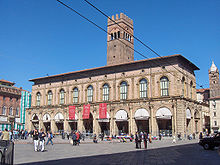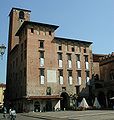Podestà
A Podestà [podesˈta] (from Latin potestas "(official) authority, power") or Podestat is an appointed governor who leads a municipality or an area.



In the Middle Ages, the local representatives of the city lords in Italian cities were called Podestà . Due to internal disputes, which made it impossible for the city to be managed by their own municipal officials due to mutual distrust, many cities also hired a non-local Podestà from the end of the 12th century , often with its apparatus of lawyers, administrative experts and soldiers. The conditions and competencies of his engagement were negotiated in detail beforehand and fixed in writing, and his inauguration took place by means of precisely defined ritualized acts. With the judiciary and command of the municipal troops, he was given extensive powers, but was subject to strict regulations and controls. He had to take an oath on the city statutes that he would unconditionally submit to the norms and rules of the community. In addition, there was the possibility of an official examination procedure after the end of his term in office and possibly the resulting substantial salary deductions. On the other hand, the quasi-dictatorial powers of the Podestà occasionally favored his rise to city lord, as with the Scaligern in Verona .
The Grisons sat in their subject territories in Valtellina , which kept them occupied from the 16th to the 18th century, Podestàs from their own leadership one. Today is mayor , for example, Poschiavo (Canton Graubünden / Switzerland ) called Podesta. A hamlet in the Avers high valley is called Podestatsch Hus, after the Podestà's house.
In Italian fascism , between 1926 and 1945, the mayors of Italy were so named to distinguish the mayor now appointed by decree from the elected sindaco of the democratic tradition.
Web links
- Marco Marcacci: Podestà. In: Historical Lexicon of Switzerland .
- Publications on the podestà in the Opac of the Regesta Imperii
literature
- Gerhard Wesenberg , Gunter Wesener : Modern German history of private law in the context of European legal development . 4th edition. Vienna / Cologne / Graz 1985, p. 34 f.
- G. Hanauer: The professional podium in the thirteenth century . Communications from the Institute for Austrian Historical Research, 23, 1902, pp. 377–426.
- V. Franchini: Saggio di ricerche su l'instituto del podestà nei comuni medievali . Bologna 1912.
- C. Ludwig: Investigations into the earliest “pedestals” of Italian cities . Vienna 1973.
- E. Artifoni: I podestà professionali e la fondazione retorica della politica comunale . Quaderni Storici, 21, 1986, pp. 687-719.
- G. Volpe: Il podestà nei comuni italiani del Duecento (1904) . In Id., Medio Evo italiano, Roma-Bari 1992, pp. 231-235.
- F. Menant: Podestat . In: Dictionnaire du Moyen Âge, a cura di C . Gauvard-A. de Libera-M. Zink, Paris 2002, p. 1118.
Individual evidence
- ↑ Edith Ennen : The European city of the Middle Ages. 4th improved edition. Vandenhoeck & Ruprecht, Göttingen 1987, ISBN 3-525-01341-8 , p. 140.


